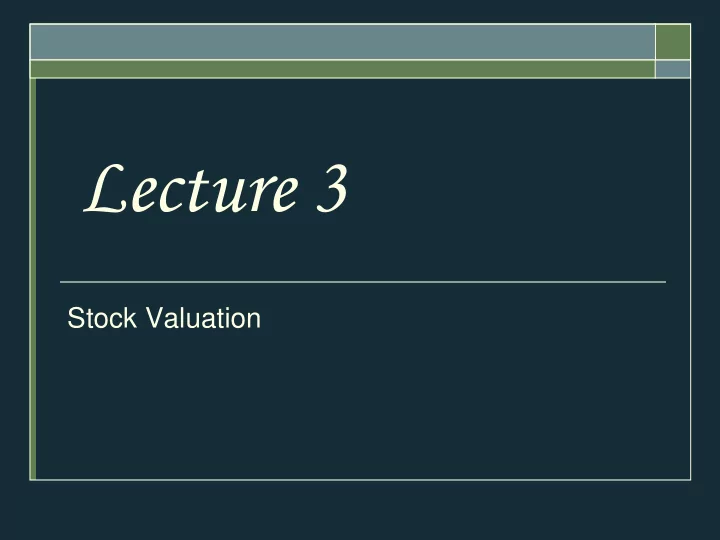

Lecture 3 Stock Valuation
Contact: Natt Koowattanatianchai Email: fbusnwk@ku.ac.th Homepage: http://fin.bus.ku.ac.th/nattawoot.htm Phone: 02-9428777 Ext. 1218 Mobile: 087- 5393525 Office: 9 th Floor, KBS Building, Kasetsart University 9-1
Outline 1 The Present Value of Common Stocks 2 Different growth assumptions 9-2
References Ross, S., Westerfield, R. and Jaffe, J. (2013), Corporate Finance (10 th Edition), McGraw Hill/Irvin. (Chapter 9) Moyer, R.C., McGuigan, J.R., and Rao, R.P. (2015), Contemporary Financial Management (13 th Edition), Cengage Learning. (Chapter 7) 9-3
The PV of Common Stocks The value of any asset is the present value of its expected future cash flows. Stock ownership produces cash flows from: Dividends Capital Gains Valuation of Different Types of Stocks Zero Growth Constant Growth Differential Growth 9-4
Case 1: Zero Growth Assume that dividends will remain at the same level forever Div Div Div 1 2 3 Since future cash flows are constant, the value of a zero growth stock is the present value of a perpetuity: Div Div Div 1 2 3 P 0 1 2 3 ( 1 ) ( 1 ) ( 1 ) R R R Div P 0 R 9-5
Case 2: Constant Growth Assume that dividends will grow at a constant rate, g , forever, i.e., Div Div ( 1 ) g 1 0 2 Div Div ( 1 ) Div ( 1 ) g g 2 1 0 3 Div Div ( 1 ) Div ( 1 ) g g 3 2 0 . . . Since future cash flows grow at a constant rate forever, the value of a constant growth stock is the present value of a growing perpetuity: Div 1 P 0 R g 9-6
Constant Growth Example Suppose Big D, Inc., just paid a dividend of $.50. It is expected to increase its dividend by 2% per year. If the market requires a return of 15% on assets of this risk level, how much should the stock be selling for? P 0 = .50(1+.02) / (.15 - .02) = $3.92 9-7
Case 3: Differential Growth Assume that dividends will grow at different rates in the foreseeable future and then will grow at a constant rate thereafter. To value a Differential Growth Stock, we need to: Estimate future dividends in the foreseeable future. Estimate the future stock price when the stock becomes a Constant Growth Stock (case 2). Compute the total present value of the estimated future dividends and future stock price at the appropriate discount rate. 9-8
Case 3: Differential Growth Assume that dividends will grow at rate g 1 for N years and grow at rate g 2 thereafter. Div Div (1 ) g 1 0 1 2 Div Div (1 ) Div (1 ) g g 2 1 1 0 1 . . . N Div Div (1 ) Div (1 ) g g 1 1 0 1 N N N Div Div (1 ) Div (1 ) (1 ) g g g N 1 N 2 0 1 2 . . . 9-9
Case 3: Differential Growth Dividends will grow at rate g 1 for N years and grow at rate g 2 thereafter 2 Div (1 ) Div (1 ) g g 0 1 0 1 … 0 1 2 Div (1 ) g 2 N N Div (1 g ) N Div (1 ) (1 ) g g 0 1 0 1 2 … … N N +1 9-10
Case 3: Differential Growth We can value this as the sum of: a T -year annuity growing at rate g 1 T ( 1 ) C g 1 1 P A T ( 1 ) R g R 1 plus the discounted value of a perpetuity growing at rate g 2 that starts in year T +1 Div T 1 R g 2 P B T ( 1 ) R 9-11
Case 3: Differential Growth Consolidating gives: Div T 1 T R g ( 1 ) C g 2 1 1 P T T ( 1 ) ( 1 ) R g R R 1 Or, we can “cash flow” it out. 9-12
A Differential Growth Example A common stock just paid a dividend of $2. The dividend is expected to grow at 8% for 3 years, then it will grow at 4% in perpetuity. What is the stock worth? The discount rate is 12%. 9-13
With the Formula 3 $ 2 ( 1 . 08 ) ( 1 . 04 ) 3 . 12 . 04 $ 2 ( 1 . 08 ) ( 1 . 08 ) 1 P 3 3 . 12 . 08 ( 1 . 12 ) ( 1 . 12 ) $ 32 . 75 $ 54 1 . 8966 P 3 ( 1 . 12 ) $ 5 . 58 $ 23 . 31 $ 28 . 89 P P 9-14
With Cash Flows 3 3 $ 2(1 . 08) $ 2(1 . 08) ( 1 . 04 ) 2 $ 2(1 . 08) $ 2(1 . 08) … 0 1 2 3 4 The constant $ 2 . 62 $ 2 . 33 $ 2 . 52 $ 2 . 16 growth phase . 12 . 04 beginning in year 4 can be valued as a 0 1 2 3 growing perpetuity at time 3 . $ 2 . 16 $ 2 . 33 $ 2 . 52 $ 32 . 75 $ 28 . 89 P 0 2 3 1 . 12 ( 1 . 12 ) ( 1 . 12 ) $ 2 . 62 $ 32 . 75 P 3 . 08 9-15
Questions?
Recommend
More recommend